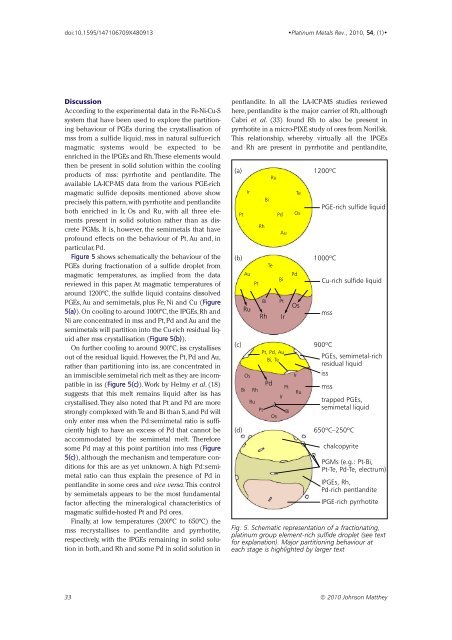Download Issue PDF - Platinum Metals Review
Download Issue PDF - Platinum Metals Review
Download Issue PDF - Platinum Metals Review
You also want an ePaper? Increase the reach of your titles
YUMPU automatically turns print PDFs into web optimized ePapers that Google loves.
doi:10.1595/147106709X480913<br />
•<strong>Platinum</strong> <strong>Metals</strong> Rev., 2010, 54, (1)•<br />
Discussion<br />
According to the experimental data in the Fe-Ni-Cu-S<br />
system that have been used to explore the partitioning<br />
behaviour of PGEs during the crystallisation of<br />
mss from a sulfide liquid, mss in natural sulfur-rich<br />
magmatic systems would be expected to be<br />
enriched in the IPGEs and Rh.These elements would<br />
then be present in solid solution within the cooling<br />
products of mss: pyrrhotite and pentlandite. The<br />
available LA-ICP-MS data from the various PGE-rich<br />
magmatic sulfide deposits mentioned above show<br />
precisely this pattern,with pyrrhotite and pentlandite<br />
both enriched in Ir, Os and Ru, with all three elements<br />
present in solid solution rather than as discrete<br />
PGMs. It is, however, the semimetals that have<br />
profound effects on the behaviour of Pt, Au and, in<br />
particular, Pd.<br />
Figure 5 shows schematically the behaviour of the<br />
PGEs during fractionation of a sulfide droplet from<br />
magmatic temperatures, as implied from the data<br />
reviewed in this paper. At magmatic temperatures of<br />
around 1200ºC, the sulfide liquid contains dissolved<br />
PGEs, Au and semimetals, plus Fe, Ni and Cu (Figure<br />
5(a)).On cooling to around 1000ºC,the IPGEs,Rh and<br />
Ni are concentrated in mss and Pt,Pd and Au and the<br />
semimetals will partition into the Cu-rich residual liquid<br />
after mss crystallisation (Figure 5(b)).<br />
On further cooling to around 900ºC, iss crystallises<br />
out of the residual liquid. However, the Pt, Pd and Au,<br />
rather than partitioning into iss, are concentrated in<br />
an immiscible semimetal rich melt as they are incompatible<br />
in iss (Figure 5(c)).Work by Helmy et al. (18)<br />
suggests that this melt remains liquid after iss has<br />
crystallised.They also noted that Pt and Pd are more<br />
strongly complexed with Te and Bi than S,and Pd will<br />
only enter mss when the Pd:semimetal ratio is sufficiently<br />
high to have an excess of Pd that cannot be<br />
accommodated by the semimetal melt. Therefore<br />
some Pd may at this point partition into mss (Figure<br />
5(c)), although the mechanism and temperature conditions<br />
for this are as yet unknown. A high Pd:semimetal<br />
ratio can thus explain the presence of Pd in<br />
pentlandite in some ores and vice versa.This control<br />
by semimetals appears to be the most fundamental<br />
factor affecting the mineralogical characteristics of<br />
magmatic sulfide-hosted Pt and Pd ores.<br />
Finally, at low temperatures (200ºC to 650ºC) the<br />
mss recrystallises to pentlandite and pyrrhotite,<br />
respectively, with the IPGEs remaining in solid solution<br />
in both, and Rh and some Pd in solid solution in<br />
pentlandite. In all the LA-ICP-MS studies reviewed<br />
here, pentlandite is the major carrier of Rh, although<br />
Cabri et al. (33) found Rh to also be present in<br />
pyrrhotite in a micro-PIXE study of ores from Noril’sk.<br />
This relationship, whereby virtually all the IPGEs<br />
and Rh are present in pyrrhotite and pentlandite,<br />
(a)<br />
Pt<br />
Ir<br />
Rh<br />
Bi<br />
Ru<br />
Pd<br />
Au<br />
Te<br />
Os<br />
1200ºC<br />
PGE-rich sulfide liquid<br />
(b) 1000ºC<br />
Te<br />
Au<br />
Pd<br />
Bi<br />
Pt<br />
Cu-rich sulfide liquid<br />
(c)<br />
(d)<br />
Bi<br />
Ru<br />
Os<br />
Rh<br />
Ru<br />
Bi<br />
Rh<br />
Pt<br />
Pt<br />
Ir<br />
Pt, Pd, Au<br />
Bi, Te<br />
Pd<br />
Os<br />
Ir<br />
Pt<br />
Bi<br />
Os<br />
Ir<br />
Ru<br />
mss<br />
900ºC<br />
PGEs, semimetal-rich<br />
residual liquid<br />
iss<br />
mss<br />
trapped PGEs,<br />
semimetal liquid<br />
650ºC–250ºC<br />
chalcopyrite<br />
PGMs (e.g.: Pt-Bi,<br />
Pt-Te, Pd-Te, electrum)<br />
IPGEs, Rh,<br />
Pd-rich pentlandite<br />
IPGE-rich pyrrhotite<br />
Fig. 5. Schematic representation of a fractionating,<br />
platinum group element-rich sulfide droplet (see text<br />
for explanation). Major partitioning behaviour at<br />
each stage is highlighted by larger text<br />
33 © 2010 Johnson Matthey
















